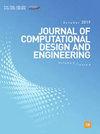电弧增材制造中多源迁移学习检测成球缺陷
IF 6.1
2区 工程技术
Q1 COMPUTER SCIENCE, INTERDISCIPLINARY APPLICATIONS
引用次数: 0
摘要
电弧增材制造(WAAM)由于其高沉积速率、高成本效率和材料多样性等优点,已成为大规模金属增材制造的一种可行工艺。然而,WAAM由于其非平衡热循环和逐层堆积机制,在工艺稳定性和零件质量方面存在一定程度的不确定性。因此,异常检测对于零件的质量监控是必要的。大多数相关研究已经应用机器学习来推导数据驱动的模型,通过特征和模式学习来检测缺陷。然而,获取足够的数据是时间和/或资源密集型的,这给应用基于机器学习的异常检测带来了挑战。本研究提出了一种多源迁移学习方法,生成异常检测模型用于球团缺陷检测,从而保证了WAAM的质量监控。该方法利用卷积神经网络模型从多源材料中提取足够的图像特征,然后对模型进行转移和微调,用于目标材料的异常检测。采用逐步学习的方法从单个源材料中依次提取图像特征,并采用复合学习的方法分配最优的冻结比例来收敛转移的和当前的特征。采用基于钨气弧焊的WAAM工艺进行了实验,验证了低碳钢、不锈钢和铬镍铁合金模型的分类精度。本文章由计算机程序翻译,如有差异,请以英文原文为准。
Detecting balling defects using multisource transfer learning in wire arc additive manufacturing
Wire arc additive manufacturing (WAAM) has gained attention as a feasible process in large-scale metal additive manufacturing due to its high deposition rate, cost efficiency, and material diversity. However, WAAM induces a degree of uncertainty in the process stability and the part quality owing to its non-equilibrium thermal cycles and layer-by-layer stacking mechanism. Anomaly detection is therefore necessary for the quality monitoring of the parts. Most relevant studies have applied machine learning to derive data-driven models that detect defects through feature and pattern learning. However, acquiring sufficient data is time- and/or resource-intensive, which introduces a challenge to applying machine learning-based anomaly detection. This study proposes a multisource transfer learning method that generates anomaly detection models for balling defect detection, thus ensuring quality monitoring in WAAM. The proposed method uses convolutional neural network models to extract sufficient image features from multisource materials, then transfers and fine-tunes the models for anomaly detection in the target material. Stepwise learning is applied to extract image features sequentially from individual source materials, and composite learning is employed to assign the optimal frozen ratio for converging transferred and present features. Experiments were performed using a gas tungsten arc welding-based WAAM process to validate the classification accuracy of the models using low-carbon steel, stainless steel, and Inconel.
求助全文
通过发布文献求助,成功后即可免费获取论文全文。
去求助
来源期刊

Journal of Computational Design and Engineering
Computer Science-Human-Computer Interaction
CiteScore
7.70
自引率
20.40%
发文量
125
期刊介绍:
Journal of Computational Design and Engineering is an international journal that aims to provide academia and industry with a venue for rapid publication of research papers reporting innovative computational methods and applications to achieve a major breakthrough, practical improvements, and bold new research directions within a wide range of design and engineering:
• Theory and its progress in computational advancement for design and engineering
• Development of computational framework to support large scale design and engineering
• Interaction issues among human, designed artifacts, and systems
• Knowledge-intensive technologies for intelligent and sustainable systems
• Emerging technology and convergence of technology fields presented with convincing design examples
• Educational issues for academia, practitioners, and future generation
• Proposal on new research directions as well as survey and retrospectives on mature field.
 求助内容:
求助内容: 应助结果提醒方式:
应助结果提醒方式:


